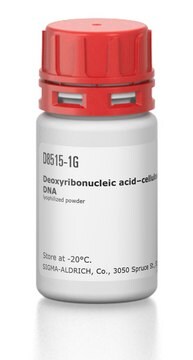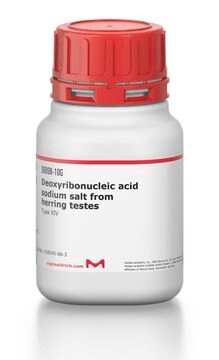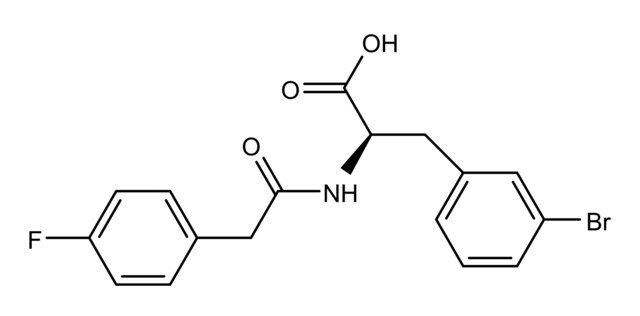D1501
Deoxyribonucleic acid sodium salt from calf thymus
Type I, fibers
Synonym(s):
ctDNA, DNA sodium salt from calf thymus, Thymonucleic acid sodium salt
Sign Into View Organizational & Contract Pricing
All Photos(6)
About This Item
Recommended Products
Looking for similar products? Visit Product Comparison Guide
Application
Calf thymus DNA (CT-DNA) is a natural DNA widely used in studies of DNA binding anticancer agents and DNA binding agents that modulate DNA structure and function. Calf thymus DNA is also used in physicochemical studies of DNA behavior in solution.
Quality
"Highly Polymerized"
Physical properties
λmax 259 nm (100 mM phosphate buffer, pH 7.0).
DNA from calf thymus is 41.9 mole % G-C and 58.1 mole % A-T.1 An OD of 1.0 at 260 nm corresponds to ~ 50 μg of double-stranded DNA.
DNA from calf thymus is 41.9 mole % G-C and 58.1 mole % A-T.1 An OD of 1.0 at 260 nm corresponds to ~ 50 μg of double-stranded DNA.
Physical form
fibrous preparation
Preparation Note
This product is extracted using a method that causes shearing yielding a highly polymerized mixture of double and single stranded DNA . However, double stranded DNA is the predominant form.
This product is prepared from calf thymus tissue of unspecified gender.
Reconstitution
Solutions of DNA have been stored successfully for several months at 4 C, pH 7.5-8, in 10 mM Tris with 1 mM EDTA and without a bacteriostatic agent. At low concentrations (μg/ml) DNA tends to absorb onto the surfaces of plastic tubes. It is not recommended to store DNA in highly alkaline solutions since DNA tends to degrade at alkaline pH greater than 8.0.
This product can be dissolved at 2 mg/ml in water. To reduce further shearing of the DNA, no sonication or stirring should be used. Gentle inversion overnight at 0-4 °C is recommended to completely solubilize the DNA. The presence of 1 mM EDTA is recommended to prevent nucleases from degrading the DNA.
Storage Class Code
11 - Combustible Solids
WGK
WGK 3
Flash Point(F)
Not applicable
Flash Point(C)
Not applicable
Personal Protective Equipment
dust mask type N95 (US), Eyeshields, Gloves
Certificates of Analysis (COA)
Search for Certificates of Analysis (COA) by entering the products Lot/Batch Number. Lot and Batch Numbers can be found on a product’s label following the words ‘Lot’ or ‘Batch’.
Already Own This Product?
Find documentation for the products that you have recently purchased in the Document Library.
Customers Also Viewed
M S Hazelton et al.
Journal of dairy science, 101(8), 7412-7424 (2018-05-14)
With the common use of bulls for breeding following a period of artificial insemination in seasonally bred dairy herds, it is important to consider the potential role of the bull in transmission of Mycoplasma spp. within and between herds. This
Alysia M Parker et al.
Veterinary microbiology, 196, 118-125 (2016-12-13)
Mycoplasma bovis is a major pathogen in cattle causing mastitis, arthritis and pneumonia. First isolated in Australian cattle in 1970, M. bovis has persisted causing serious disease in infected herds. To date, genetic analysis of Australian M. bovis isolates has
Hironobu Ikehata et al.
Photochemical & photobiological sciences : Official journal of the European Photochemistry Association and the European Society for Photobiology, 17(4), 404-413 (2018-02-22)
The amount of photolesions produced in DNA after exposure to physiological doses of ultraviolet radiation (UVR) can be estimated with high sensitivity and at low cost through an immunological assay, ELISA, which, however, provides only a relative estimate that cannot
Oskar Szczepaniak et al.
Biomolecules, 10(5) (2020-05-06)
Since ancient times, fruits and edible plants have played a special role in the human diet for enhancing health and maintaining youthfulness. The aim of our work was to determine the interactions between naringin, a natural ingredient of grapefruits, and
A M Parker et al.
Journal of dairy science, 99(12), 9875-9884 (2016-10-04)
Bacterial contamination of milk fed to calves compromises calf health. Several bacterial pathogens that infect cows, including Mycoplasma bovis and Salmonella enterica ssp. enterica serovar Dublin, are shed in milk, providing a possible route of transmission to calves. Milk acidification
Protocols
Enzymatic Assay of Nuclease S1
Our team of scientists has experience in all areas of research including Life Science, Material Science, Chemical Synthesis, Chromatography, Analytical and many others.
Contact Technical Service













